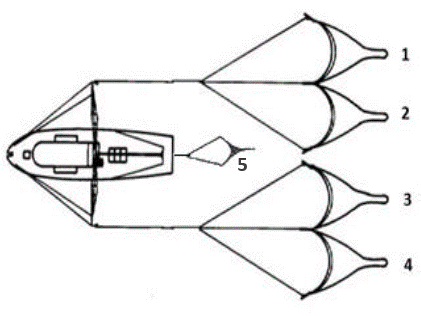Trash-and-Turtle Excluder Devices (TTEDs)
to reduce bycatch in Suriname’s seabob shrimp trawl fishery
Target species:
Seabob shrimp (Xiphopenaeus kroyeri)
Area, Vessel
The study was carried out on commercial seabob fishing grounds, in the eastern part of the Suriname’s shelf on board 2 vessels. Both vessels are typical ca. 20m-long, 425 hp ‘Florida-type’ outrigger trawlers (quad-rig system). Besides the four main trawls (1-4), the seabob fishery uses a try-net (5) to assess potential shrimp catches before and during fishing operation.
Seabob shrimp (Xiphopenaeus kroyeri)
Area, Vessel
The study was carried out on commercial seabob fishing grounds, in the eastern part of the Suriname’s shelf on board 2 vessels. Both vessels are typical ca. 20m-long, 425 hp ‘Florida-type’ outrigger trawlers (quad-rig system). Besides the four main trawls (1-4), the seabob fishery uses a try-net (5) to assess potential shrimp catches before and during fishing operation.
Gear type:
demersal
Gear modification
The control TED (a) was the standard 4“ TED used in the commercial seabob fishery. The experimental TTEDs had bar spacings of 3” (7.6 cm) and 2” (5.1 cm). They had flattened vertical bars (0.5 cm wide) to reduce drag through the water. The 13 (b) or 18 (c) vertical bars were supported by a horizontal pipe near the middle of the device. Both TEDs and TTEDs were installed in a downward-excluding configuration with a double net flap covering the bottom escape opening.
demersal
Gear modification
The control TED (a) was the standard 4“ TED used in the commercial seabob fishery. The experimental TTEDs had bar spacings of 3” (7.6 cm) and 2” (5.1 cm). They had flattened vertical bars (0.5 cm wide) to reduce drag through the water. The 13 (b) or 18 (c) vertical bars were supported by a horizontal pipe near the middle of the device. Both TEDs and TTEDs were installed in a downward-excluding configuration with a double net flap covering the bottom escape opening.



Results:
The 2” TTED reduced significantly the bycatch of fish. The 3” TTED caused a significant reduction in ray bycatch, increased the capture of seabob shrimp by 16 %, and had no effect on capture of retained fish. Percentages in the graphics denote reduction or increase in mean CPUE in the experimental codend. * indicates significant differences, while ns = not significant.
The 2” TTED reduced significantly the bycatch of fish. The 3” TTED caused a significant reduction in ray bycatch, increased the capture of seabob shrimp by 16 %, and had no effect on capture of retained fish. Percentages in the graphics denote reduction or increase in mean CPUE in the experimental codend. * indicates significant differences, while ns = not significant.
Further information:
Tomas.Willems@fao.org

Tomas.Willems@fao.org


Citation :
, 2017.
Trash-and-Turtle Excluder Devices (TTEDs)
. In O’Neill, F.G. and Mutch, K. (Eds): Selectivity in Trawl Fishing Gears. Scottish Marine and Freshwater Science Vol 8 No 1.